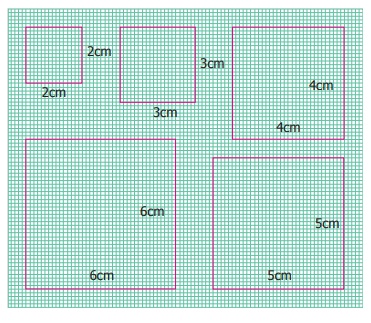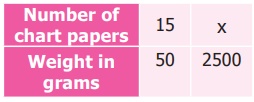Term 1 Chapter 4 | 7th Maths - Direct Proportion | 7th Maths : Term 1 Unit 4 : Direct and Inverse Proportion
Chapter: 7th Maths : Term 1 Unit 4 : Direct and Inverse Proportion
Direct Proportion
Direct
Proportion
For example, if the cost of a shirt is ₹ 500,
then the price of 3 shirts will be ₹ 1,500. The price of the shirts increases as the
number of shirts increases. Proceeding the same way we can find the cost of any
number of such shirts.
When observing the above situation, two quantities
namely the number of shirts and their prices are related to each other. When the
number of shirts increases, the price also increases in such a way that their ratio
remains constant.
Let us denote the number of shirts as x and the price of shirts as y rupees. Now observe the following table

From the table, we can observe that when the values
of x increases the corresponding values
of y also increases in such way that the
ratio x/y in each case has the same value which is a constant
(say k).
Now let us find the ratio for each of the value from the table.
x/y = 1/500 = 2/1000 = 3/1500 = 6/3000 = 7/3500
and so on. All the ratios are equivalent and its simplified form is 1/500.
In general, x/y = 1/500 = k (k is a constant)
When x and y are in direct proportion, we get x/y = k or x = ky
(k is a constant)
Considering any two ratios given above, say, 2/1000
= 6/3000, where 2(x1) and 6
(x2) are the number of
shirts (x) and 1000 (y1) and 3000 (y2) are their prices (y). So, when x and y are in direct proportion
we can write x1/y1 = x2/y2
[where, y1, y2 are values of y corresponding to the values x1, x1 of x].
Think
The number of chocolates to be distributed
to the number of children. Is this statement in direct proportion?
Try this
Observe the following 5 squares of different sides given in the graph
sheet

The measures of the sides are recorded in the table given below.
Find the corresponding perimeter and the ratios of each of these with the sides
given and complete the table.

From the information so obtained state whether the side of a square
is in direct proportion to the perimeter of the square
Think
When a fixed amount is deposited for
a fixed rate of interest, the simple interest changes propotionaly with the number
of years it is being deposited. Can you find any other examples of such kind.
Example 4.1
If 6 children shared 24 pencils equally, then how
many pencils are required for 18 children?
Solution
Let x be
the number of pencils required for 18 children. As the number of children increases,
number of pencils also increases.

In the case of direct proportion we take

Hence, 72 pencils are required for 18 children.
Example 4.2
If 15 chart papers together weigh 50 grams, how
many of the same type will be there in a pack of 2 1/2 kilogram?
Solution
Let x be
the required number of charts.

As weight increases, the number of charts also increases.
So the quantities are in direct proportion.


Therefore, 750 charts will weigh 2 ½ kilogram.
Unitary
Method
We know the concept of unitary method studied in
the previous class.
First, the value of one unit will be found. It will
be useful to find the value of the required number of units. We will try to solve
more problems using unitary method.
Example 4.3
Anbu bought 2 notebooks for ₹ 24.
How much money will be needed to buy 9 such notebooks?
Solution
Using unitary method we can solve this as follows:
The cost of 2 notebooks = ₹ 24
The cost of 1 notebook = 24/2 =₹12
Therefore, the cost of 9 notebooks = 9×₹12
= ₹ 108
Hence, Anbu has to pay ₹108
for 9 notebooks.
Example 4.4
A car travels 90km in 2hours 30minutes. How much
time is required to cover 210km?
Solution
1 hour = 60 minutes
2 hour = 120 minutes
Time taken to cover 90 km = 2hrs 30mins
= 150 minutes
Time taken to cover 1 km = 150/90 minutes.
Time taken to cover 210 km = 150/90 × 210 minutes
= 350 minutes
= 5 hours 50 minutes
Thus, the time taken to travel 210 km is 5 hours 50 minutes
Related Topics